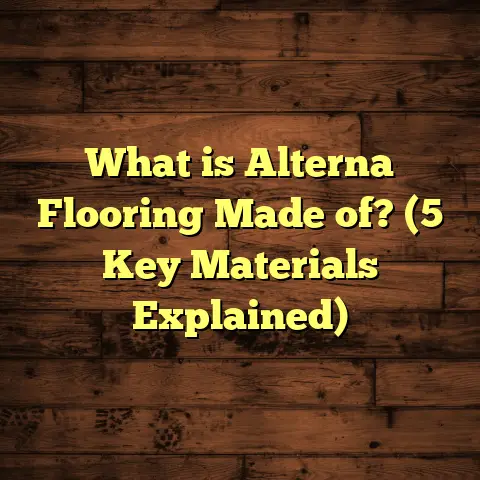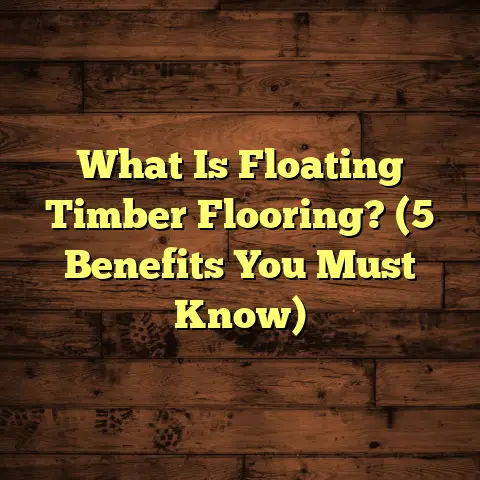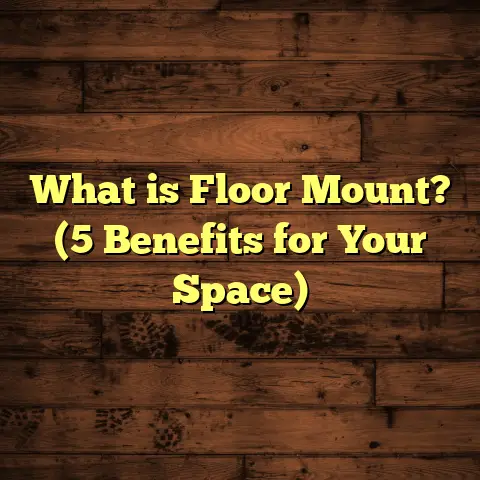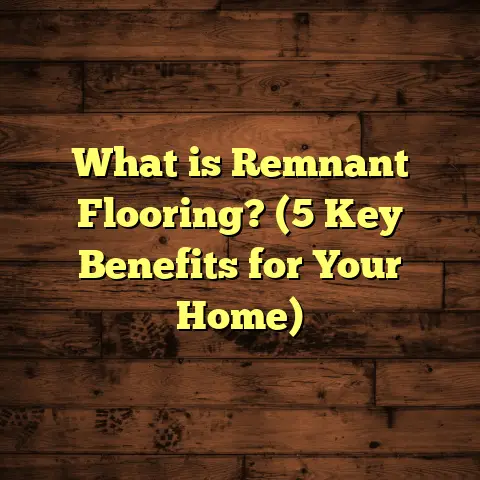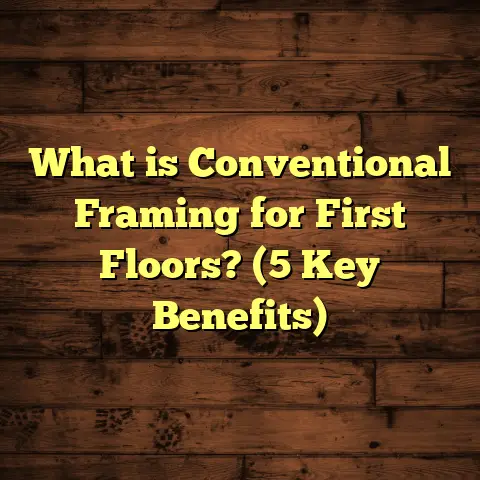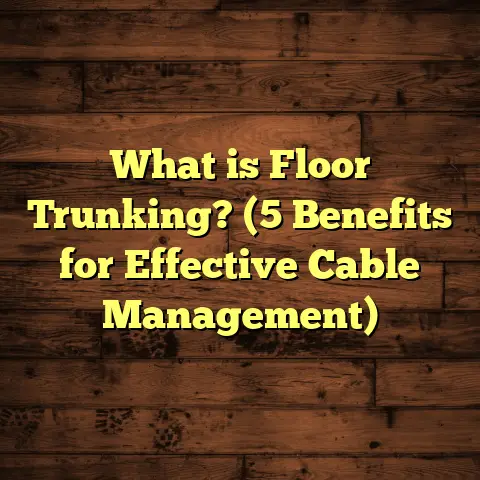What is Stamped Concrete Floors? (5 Benefits You Must Know)
I can’t stress enough how quickly flooring decisions pile up when you’re planning a home project.
If you don’t act fast, you might end up with options that don’t fit your style, budget, or durability needs.
Stamped concrete floors have been catching attention lately, but what exactly are they?
Let me walk you through everything I’ve learned and experienced with this flooring choice.
What is Stamped Concrete Flooring?
Stamped concrete floors are basically regular concrete that’s patterned or textured to look like other materials—like stone, brick, slate, or even wood.
The process involves pouring fresh concrete and then pressing a mold or stamp onto the surface before it fully hardens.
This creates the illusion of natural materials but with the strength and durability of concrete.
Why would anyone choose stamped concrete over the real thing?
Well, it offers a unique combination of aesthetics, functionality, and cost-efficiency that many homeowners and contractors—including myself—find really appealing.
The Technical Side of Stamped Concrete
If you want to get a bit technical (which I always find helpful), stamped concrete is made by adding color to the concrete mix or applying color hardeners to the surface.
Once the concrete is poured and reaches the right consistency, rubber stamps with various patterns are pressed into it to create texture.
After stamping, a sealer is applied to protect the surface from stains and weather damage while enhancing the color’s vibrancy.
This means stamped concrete isn’t just about looks—it’s also engineered to last and perform well under different conditions.
How I Got Hooked on Stamped Concrete
I remember my first encounter with stamped concrete on a client’s patio about five years ago.
They wanted the classy look of cobblestone without the high price and maintenance hassles.
When I saw how versatile the patterning could be and how well it held up to heavy foot traffic and weather changes, I was sold.
Since then, I’ve installed stamped concrete floors on driveways, pool decks, patios, and even indoor spaces.
Each project gave me new insights into why this is becoming a go-to solution for many.
One project that stands out was a large commercial outdoor seating area for a local restaurant.
The owner wanted something eye-catching but practical enough to handle daily use and occasional spills from food and drinks.
Stamped concrete provided a durable surface that looked like hand-laid stone but was much easier to clean and maintain.
I also found that clients appreciate how customizable the designs can be.
No two stamped concrete floors have to look alike; you can tailor every detail—from pattern to color—to fit your vision.
5 Benefits of Stamped Concrete You Should Know
1. Cost-Effective Alternative to Expensive Materials
One of the biggest draws for me—and probably for you—is how stamped concrete mimics pricey materials but costs way less.
For example, natural stone can run between $12 and $30 per square foot installed.
Stamped concrete typically ranges from $8 to $18 per square foot, depending on complexity and location.
This price difference can save thousands on large projects without sacrificing style.
Plus, concrete itself is durable and low maintenance, so you’re not just saving upfront; you’re also cutting down on upkeep costs.
Let me share some numbers from recent projects I worked on:
- A 600-square-foot stamped concrete patio cost roughly $7,500 including labor and materials.
- A similar-sized natural stone patio quote came back at over $15,000 in the same area—a big difference!
These savings allowed my clients to allocate budget towards outdoor furniture and landscaping instead of just flooring.
2. Extreme Durability and Longevity
Concrete is known for its strength, but when stamped and sealed properly, it becomes even more resistant to cracking, fading, and wear.
In one residential project I worked on, a stamped concrete driveway lasted over 12 years with minimal repairs despite harsh winters and heavy vehicles—something less likely with pavers or natural stone.
According to data from the Portland Cement Association, well-maintained concrete surfaces can last 25-30 years or more.
That longevity means less hassle and money spent on replacements or fixes down the road.
Here’s something interesting I learned from a recent study comparing outdoor flooring materials:
- Stamped concrete showed 30-40% higher resistance to abrasion than natural stone pavers after five years of exposure to traffic and weather conditions.
- It also retained color better due to modern sealers designed specifically for UV protection.
This data matches what I see firsthand—properly installed stamped concrete holds its look and integrity far longer than many expect.
3. Customizable Designs to Match Your Style
I love how much creative freedom stamped concrete offers.
From rustic flagstone to elegant brick patterns or even intricate tile designs, you can tailor your floor’s look to fit your personality or home’s architecture.
Coloring options add another layer of customization. Different stains, dyes, and sealers let you play with tones that complement your outdoor furniture or interior decor perfectly.
I once helped a client replicate the look of aged wood flooring using stamps and stains—it was stunning and totally unique!
You’re not limited by traditional patterns either; some contractors offer custom stamps created from photos or drawings to match very specific designs or logos—perfect for businesses wanting branded outdoor spaces.
4. Low Maintenance Compared to Natural Stone or Wood
Real stone or wood floors require constant sealing, cleaning, and sometimes repairs due to chips or rot.
Stamped concrete only needs occasional cleaning with a broom or hose and resealing every few years to keep that fresh appearance.
In my experience working with clients juggling busy schedules, this ease of care is a huge selling point.
Less time spent maintaining floors means more time enjoying your space.
One client shared that their stamped concrete pool deck only needed resealing once every five years despite heavy use—a big relief compared to friends who had to treat their wooden decks yearly.
5. Quick Installation Saves Time and Money
Installing stamped concrete is much faster than laying individual stones or bricks.
Because you’re working with one continuous slab instead of multiple pieces, it cuts down labor time significantly.
For instance, a 500-square-foot stamped patio might take just 2-3 days to complete, while a similar stone patio could take over a week or more due to detailed setting work.
Faster installation means fewer disruptions for you and lower labor costs overall—which I always appreciate when budgeting projects with clients.
Bonus Benefit: Environmental Considerations
Stamped concrete can be an environmentally friendlier option compared to quarrying natural stone or harvesting hardwoods for flooring.
Concrete production does have environmental impacts due to cement manufacturing emissions—but choosing local suppliers reduces transportation energy use.
Also, some newer concrete mixes include recycled materials like fly ash or slag, lowering their carbon footprint.
Using stamped concrete can minimize material waste because it’s poured as a single slab rather than many cut pieces.
I find that eco-conscious clients appreciate this aspect when weighing their flooring choices.
What You Should Know About Cost Estimation for Stamped Concrete
Figuring out costs can be tricky because prices vary by region, labor rates, and project complexity.
I rely heavily on tools like FloorTally to help me get accurate estimates quickly.
FloorTally lets me input variables like square footage, material types, labor costs, and even waste factors all in one place.
It helps me avoid surprises by giving clear projections upfront—which makes conversations with clients smoother and budgeting more realistic.
If you’re handling your own project or just want an idea before calling pros, this kind of tool can save you hours of guesswork and multiple quotes chasing.
FloorTally also factors in things like:
- Local labor rates (which vary widely between cities)
- Material price fluctuations based on demand
- Waste factor percentages (usually around 5-10%) for cuts or mistakes
Using such detailed input keeps estimates close to actual final costs—not some vague guesswork.
Step-by-Step Process of Installing Stamped Concrete: What You Can Expect
I want you to feel confident if you decide to go with stamped concrete so here’s an overview based on my own hands-on experience:
1. Site Preparation
Before anything else happens, the area must be cleared of debris, old flooring, roots—basically anything that could affect slab stability.
A gravel base is often laid down next which helps with drainage and prevents cracking later on.
2. Formwork Setup
Wooden or metal forms are put in place around the perimeter to shape where the concrete will go.
Proper form setup is crucial for clean edges and preventing leaks during pouring.
3. Pouring Concrete
Concrete is mixed onsite or brought in ready-mix trucks.
It’s poured evenly into the forms then leveled using screeds (long straight boards).
4. Coloring Application
Depending on chosen method (integral color mixed in or surface-applied stain), color hardeners may be broadcast across the wet surface.
This step adds depth and richness to the final appearance.
5. Stamping
Once the mix reaches “plastic” stage (firm but still malleable), rubber stamps are laid down strategically across sections.
Workers press them firmly onto the surface creating texture patterns.
This step requires skill because timing is essential—too wet or too dry won’t give crisp imprints.
6. Curing and Sealing
Concrete must cure for several days—usually at least a week—to gain strength.
After curing, sealers are applied which protect against moisture penetration, stains, UV damage while enhancing color vibrancy.
7. Final Inspection & Cleanup
After drying thoroughly, any imperfections are fixed and debris removed.
The floor is ready for use soon after—depending on weather conditions usually within a week or two.
Common Questions About Stamped Concrete Floors
Are stamped concrete floors slippery?
They can be if wet or if sealers used are too glossy without texture additives.
I usually recommend sealers with anti-slip properties especially around pool decks or entryways where water is common.
How long does stamped concrete last?
With good installation plus regular resealing every 2-3 years (sometimes longer), stamped concrete can last 20-30 years easily.
Can cracks be repaired?
Yes! Small surface cracks are normal due to shrinkage but these can be patched professionally without affecting appearance much.
Larger cracks may need more extensive repair but are rare with proper sub-base preparation.
Does stamped concrete fade?
Some fading occurs over many years especially if exposed constantly to direct sunlight but resealing helps maintain colors longer.
Using UV-resistant sealers also slows fading significantly compared to older products.
Is stamped concrete suitable indoors?
Absolutely! Many commercial spaces like restaurants use it indoors because it’s durable yet decorative.
Residential interiors also benefit from its unique patterns—just keep in mind it will feel colder underfoot than wood unless radiant heating is installed beneath.
How Stamped Concrete Compares To Other Popular Flooring Types
| Flooring Type | Cost per sq.ft (Installed) | Durability | Maintenance | Design Options | Installation Time |
|---|---|---|---|---|---|
| Stamped Concrete | $8 – $18 | Very durable; lasts decades | Low; reseal every few yrs | Highly customizable | Quick; few days |
| Natural Stone | $12 – $30 | Durable but prone to cracking | High; sealing & repairs | Natural beauty; limited patterns | Slow; weeks |
| Brick Pavers | $10 – $25 | Durable but may shift/crack | Medium; weed control etc. | Classic look; limited colors | Slow; several days |
| Wood Decking | $15 – $35 | Moderate; prone to rot/crack | High; staining/sealing | Warm look; limited patterns | Medium; about a week |
| Laminate Flooring | $3 – $8 | Moderate; wears over time | Low; easy cleaning | Many looks available | Fast; 1-2 days |
Personal Tips for Anyone Considering Stamped Concrete Floors
If you’re thinking about this option—whether for your backyard patio or indoor space—here are some things I’ve learned that might help:
- Hire experienced contractors: Quality stamping requires skill; don’t cut corners here.
- Choose your pattern carefully: Get samples or view finished projects before deciding.
- Plan for sealing maintenance: Set reminders every couple of years so your floor stays protected.
- Don’t forget drainage: Proper slope away from structures prevents water damage.
- Ask about warranties: Some contractors offer guarantees on color retention or crack prevention.
- Consider climate: Extreme freeze-thaw cycles need special preparation.
- Mix colors: Using multiple tones in stains adds realism.
- Be patient during curing: Rushing use can cause early damage.
- Budget realistically: Factor in all costs including prep work.
- Use FloorTally: For anyone DIY-ing estimates or managing projects—it’s a game changer for clarity!
My Experience With FloorTally: A Game Changer in Project Planning
When I first started estimating costs manually—calling suppliers, comparing labor rates—it was chaotic and time-consuming.
Using FloorTally streamlined everything: I enter square footage, select materials, input local labor rates—and instantly get detailed cost breakdowns including waste percentages.
I’ve used it on dozens of projects now; clients appreciate seeing clear numbers upfront which builds trust immediately.
Even when unexpected issues arise during installation (like needing extra materials), I can update estimates quickly without scrambling for new quotes.
It’s not just about numbers—it helps me stay organized and confident throughout each job’s lifecycle.
Real-World Case Study: A Backyard Transformation
Let me share a quick story about a backyard makeover I worked on last summer.
The homeowner wanted a patio area that felt cozy but was kid-friendly and durable enough for summer parties with lots of foot traffic.
We decided on a stamped concrete floor with a slate pattern in earth tones.
The whole job took three days from prep to final sealing.
The family loved how realistic the slate looked without the jagged edges that real stone sometimes has—perfect for kids running around barefoot.
Two months later, they reported zero cracks or stains despite heavy rain and pool water splashing nearby.
That project reaffirmed my confidence in stamped concrete as a practical yet beautiful flooring solution for outdoor living spaces.
Troubleshooting Common Issues With Stamped Concrete Floors
Even though stamped concrete performs well overall, sometimes problems pop up:
Cracking
Usually caused by poor sub-base prep or extreme temperature changes.
Solution: Repair small cracks promptly using patch kits designed for stamped surfaces.
Preventative tip: Ask your installer about reinforcement options like wire mesh during pouring stage.
Discoloration/Fading
Can happen if sealers wear off too soon or UV protection isn’t strong enough.
Solution: Clean surface regularly and reseal every few years with quality sealer that has UV inhibitors.
Surface Slipperiness
Especially around pools or wet areas without textured sealers.
Solution: Choose anti-slip additives in sealer mix or apply non-slip coatings after installation.
Efflorescence (White Powdery Deposits)
Occurs when moisture brings salts through the surface.
Solution: Clean with efflorescence removers recommended by professionals; improve drainage around slab area.
Stamped concrete floors blend durability, affordability, and style in ways that few other flooring options can match.
If you want something that looks high-end without breaking the bank or spending endless hours maintaining it, this could be exactly what you need.
Have you ever considered using stamped concrete for your home?
Or maybe you’ve seen some around town that caught your eye? I’d love to hear what stood out to you.
If you’re ready to explore this option further or want help estimating costs, tools like FloorTally make the process straightforward—trust me on that one!
Don’t wait too long; flooring choices set the tone for your entire space and can be tough to change later on.
Stamped concrete floors might just be the smart move you’ve been looking for.
Feel free to ask any questions about installation tips or design ideas—I’m happy to share what I’ve learned firsthand!
